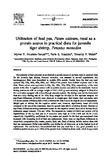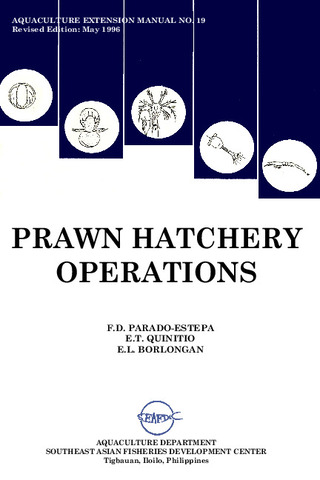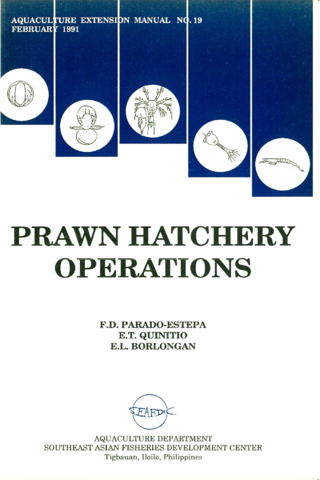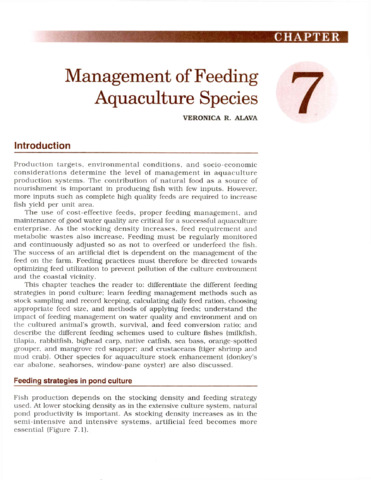Utilization of feed pea, Pisum sativum, meal as protein source in practical diets for juvenile shrimp, Penaeus monodon
Share
Abstract
The potential of feed pea meal as an alternative protein source to soybean meal in practical diets for the juvenile tiger shrimp, Penaeus monodon, was assessed in several experiments. Six isonitrogenous diets were formulated to contain 40% protein. Protein from the feed pea meal replaced 0%, 20%, 40%, 60%, 80%, and 100% of the protein from defatted soybean meal in the diets. These values were equivalent to 0%, 5%, 10%, 15%, 20%, 25%, respectively, of the total protein in the diet. A negative control with no protein sources was added to the treatments. Twelve shrimp post-larvae with an average weight of 0.02±0.01 g were randomly assigned in thirty-five 60-l oval tanks equipped with a flow-through seawater system. The shrimp were fed the formulated diets at a daily feeding rate of 20–25% body weight for 90 days in five replicate samples. No significant differences (P>0.05) were observed in weight gain, feed intake, feed conversion ratio (FCR) and protein efficiency ratio (PER) of shrimp fed diets 0 up to the highest level of replacement. Weight gain of shrimp fed the negative control was, however, significantly lower (P<0.05) compared to the rest of the treatments. Specific growth rates (SGR) of shrimp showed likewise no significant differences among treatments except for the negative control. Survival of shrimp for all treatments ranged between 75% and 100%. The apparent dry matter (ADMD) and protein (APD) digestibilities of the dry feed pea in P. monodon were high at 73.38±4.98 and 92.74±2.62, respectively. Digestibility coefficients for dry matter and protein for the feed pea meal-based diets increased with increasing level of feed pea replacement. There were no significant differences in whole body composition (dry matter, protein, lipid, ash, fiber) of shrimp fed the various diets with feed pea replacement. Pellet water stability was similar for all diets even up to the highest level of replacement. The results have demonstrated that feed pea meal has a very good potential as a substitute protein source up to 100% of the protein from defatted soybean meal, which is equivalent to 25% of the total protein in the diet. An inclusion level of up to 42% in the juvenile shrimp P. monodon practical diet did not manifest any adverse effects on growth, feed intake, FCR, survival, body composition, and digestibility coefficients for dry matter and protein of the shrimp.
Suggested Citation
Bautista-Teruel, M. N., Eusebio, P. S., & Welsh, T. P. (2003). Utilization of feed pea, Pisum sativum, meal as protein source in practical diets for juvenile shrimp, Penaeus monodon. Aquaculture , 225(1-4), 121-131. https://doi.org/10.1016/S0044-8486(03)00284-9
Subject
Taxonomic term
Collections
- AQD Journal Articles [1249]
Related items
Showing items related by title, author, creator and subject.
-
Prawn hatchery operations
Parado-Estepa, Fe D.; Quinitio, Emilia T.; Borlongan, Emeterio L. (Aquaculture Department, Southeast Asian Fisheries Development Center, 1996-05)The manual, an updated version of the 1984 SEAFDEC/AQD manual, presents the underlying principles and step-by-step instructions of prawn larval and post-larval rearing. The techniques described are not only applicable to ... -
Prawn hatchery operations
Parado-Estepa, Fe D.; Quinitio, Emilia T.; Borlongan, Emeterio L. (Aquaculture Department, Southeast Asian Fisheries Development Center, 1991-02)The manual, an updated version of the 1984 SEAFDEC/AQD manual, presents the underlying principles and step-by-step instructions of prawn larval and post-larval rearing. The techniques described are not only applicable to ... -
Management of feeding aquaculture species
Alava, Veronica R. (Aquaculture Department, Southeast Asian Fisheries Development Center, 2002)This chapter teaches the reader to: differentiate the different feeding strategies in pond culture; learn feeding management methods such as stock sampling and record keeping, calculating daily feed ration, choosing ...




